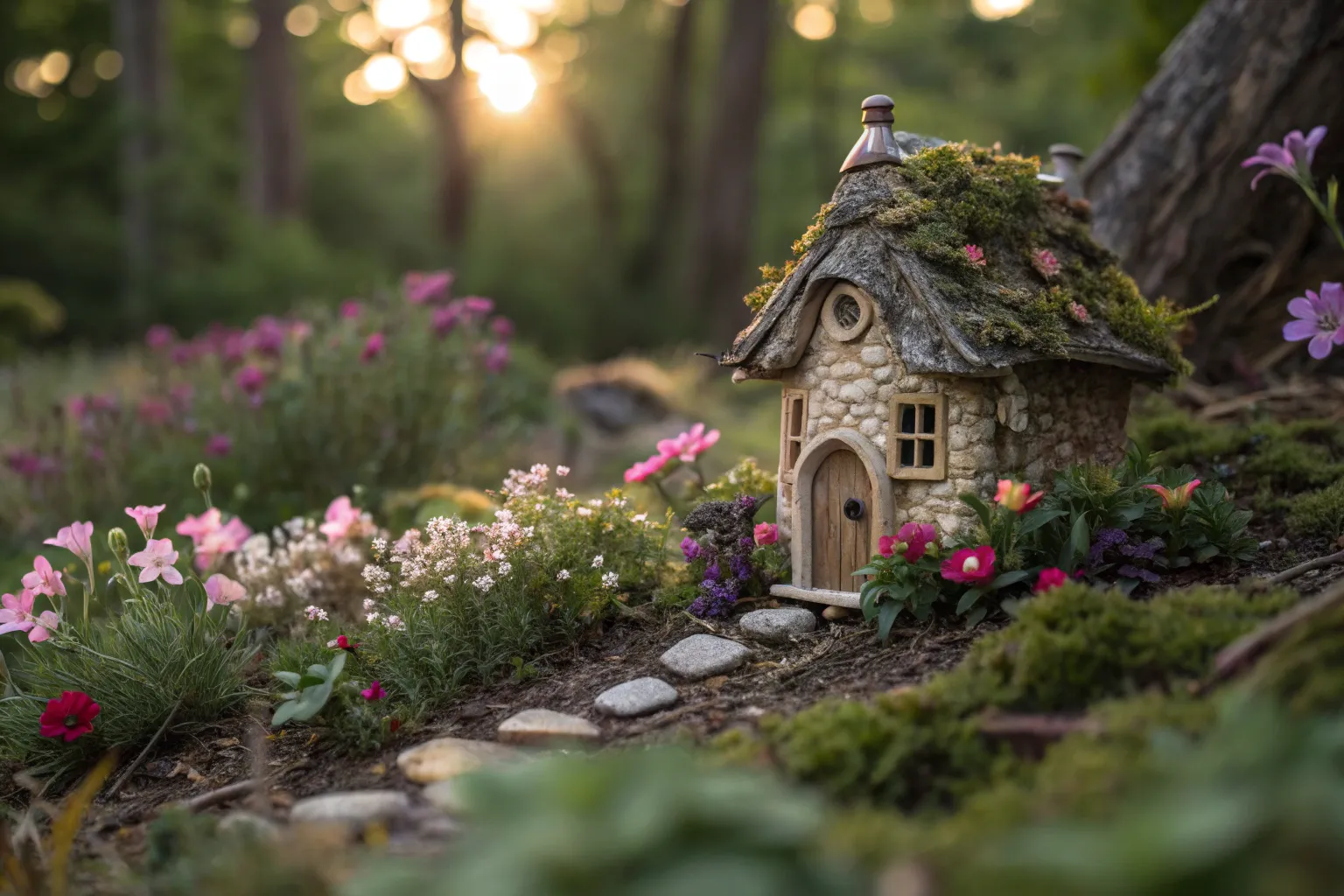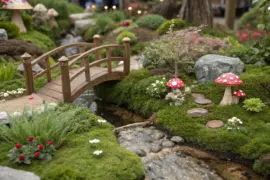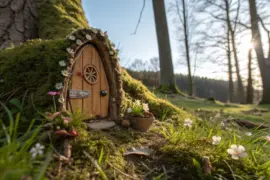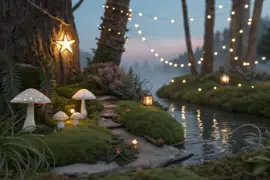Creating miniature fairy dwellings connects us to something deeply human: the impulse to imagine, to build, and to make wonder tangible. Whether you’re crafting with your children on a rainy afternoon or losing yourself in the meditative rhythm of shaping clay, these tiny structures offer an escape into enchantment. The beauty lies not in perfection, but in the layers of texture, the unexpected details, and the stories that emerge as you work.
Gathering Your Foundation Materials

The best part about miniature building is that you likely have most materials already at home. Cardboard becomes your primary construction material—save cereal boxes, pizza boxes, and shipping containers. Toilet paper tubes transform into perfect tower bases or mushroom stems. For covering and sculpting, air-dry clay works beautifully and doesn’t require an oven. You can even make homemade versions using plaster of Paris, flour, glue, and paper.
Other essentials include hot glue or white craft glue, acrylic paints in earthy tones, and texture-makers like wire brushes or crumpled aluminum foil. For natural elements, collect pinecones (their scales make wonderful roof shingles), moss, small twigs, bark pieces, and pebbles during woodland walks.
Building Your Tower Structure

I find towers particularly rewarding because they let you play with vertical space and create multiple stories within a small footprint. Start by determining your tower’s height—anywhere from six inches to a foot works well for beginners. Stack cardboard tubes or roll sheets of cardboard into cylinders, securing with hot glue.
For a multi-story tower, cut window openings at different heights before you cover everything with clay. You can create balconies by gluing small cardboard platforms that extend outward, then adding tiny railings from twigs or strips of cardboard folded into decorative patterns. The chimney detail adds character—fashion it from a smaller tube or rolled cardboard cone, positioning it asymmetrically for a more organic look.
The roof deserves special attention. For a conical tower top, cut a half-circle from cardboard, form it into a cone, and secure the edges. Add dimension by layering on shingles cut from cardboard—irregular shapes painted in grays and browns create the weathered look of ancient slate. Alternatively, use pinecone scales glued in overlapping rows for a natural textured roof that catches light beautifully.
Crafting Mushroom Houses

Mushroom houses have a whimsical personality all their own. Their rounded forms feel both fantastical and familiar, like something you might discover hidden beneath a garden fern.
Begin with the stem—a toilet paper tube works perfectly, or roll cardboard into a cylinder about three to four inches tall. Cut your doorway and round windows while the structure is still bare cardboard. For a truly circular mushroom, create the cap using a technique that gives surprising roundness: trace a large circle on cardboard, divide it into eight or twelve wedge-shaped slices, then glue these vertically around a smaller circular base. The more slices you use, the rounder your mushroom cap becomes. Some crafters cut a cone from foam board and shape it with sandpaper for an even smoother dome.
Once your basic structure stands firm, cover everything with a layer of air-dry clay. This is where texture comes alive. Use a damp sponge to create the porous surface of a real mushroom cap, or press wrinkled aluminum foil against the clay for an organic texture. For the underside of your mushroom cap, score gentle lines radiating from the center to suggest the gills you’d find beneath an actual toadstool.
Add charming details like stones around the base—crumpled paper or small clay pieces pressed flat create convincing rocks. Vines climbing up one side can be shaped from twisted strips of clay or brown paper, with tiny leaf shapes attached along their length.
Creating Doors, Windows, and Details

Details transform a simple structure into a home. Windows deserve frames—cut thin strips of cardboard or craft sticks and glue them around each opening to create depth. You can add translucent “glass” by gluing thin plastic or wax paper behind the window frames. This works especially well if you plan to add lighting later.
Doors can be fashioned from cardboard with wood grain drawn using a thin paintbrush, or built up from popsicle sticks arranged vertically. Add a tiny bead or button as a doorknob, and perhaps a miniature wreath made from twisted wire and snippets of moss. Arched doorways feel particularly fairy-tale appropriate—simply round the top corners when cutting your opening.
Wooden siding gives charming texture to towers. Cut foam board or thin cardboard into narrow strips, then score horizontal lines with a ballpoint pen or scratch vertical wood grain with a wire brush. Glue these “planks” in slightly overlapping rows around your structure. Once painted, they’re remarkably convincing.
Mastering Color and Painting

Painting brings your creation to life, and the layering technique makes all the difference. Start with a base coat in the dominant color—earthy browns for stems and towers, warm reds or tans for mushroom caps. Let this dry completely.
The magic happens with washes and dry-brushing. Mix a darker shade with water until it’s quite thin, then brush this over your base color, letting it pool in crevices and textures. This creates shadows and depth. Once that’s dry, lightly dry-brush a lighter color—dip your brush in paint, wipe most of it off on a paper towel, then sweep what remains across raised surfaces. This highlights texture and makes details pop.
For mushroom caps, consider the classic red with white spots for an instantly recognizable toadstool, or explore natural variations—browns with cream, deep oranges, or even soft pinks and lavenders for a more whimsical approach. Paint the underside of mushroom caps a creamy yellow-white to mimic real gills.
Windows glow when painted bright yellow or orange inside, as though candlelight flickers within. Add tiny dark squares to suggest window panes divided by muntins.
Adding Texture Through Natural Materials
Moss brings instant realism and softness to your scenes. Sheet moss (available at craft stores) can be torn into pieces and glued around the base of your structures, along pathways, or climbing up one side of a tower. Reindeer moss—the fluffy kind that comes in various colors—works beautifully as bushes or ground cover.
For grass effects, you can use the fuzzy surface of green felt, actual preserved moss, or even create your own by forcing air-dry clay through a fine tea strainer, letting the resulting “spaghetti” dry slightly before gluing in tufts. Some crafters mix fine green model railroad flock with glue for a textured grass effect.
Pebbles and small stones define pathways and boundaries. Arrange them leading to doorways or circling around your structure. Aquarium gravel works well for this, or collect interesting pebbles during beach walks.
Lighting Your Miniature World
Few things enchant more than a fairy house glowing from within. Battery-operated LED lights or small string lights make this surprisingly achievable. Before you seal your structure completely, tuck a battery-operated tea light inside, or thread a strand of mini lights through windows.
For beginners, the simplest approach is placing a small LED push-light inside an open-backed structure, or positioning your house near a string of outdoor fairy lights. The warm glow through windows and doorways transforms your creation, especially magical during evening hours.
More advanced crafters can use copper tape to create simple circuits, connecting small LED bulbs to a battery pack hidden in the base. This requires planning your wiring before adding clay and details, but creates a polished result.
Understanding Scale and Proportion
Getting scale right helps your miniature world feel cohesive. Most fairy garden accessories work at roughly 1:12 scale, meaning one inch in your miniature equals one foot in real life. A six-inch tower in this scale would represent a six-foot-tall structure—perfectly sized for fairies.
When adding furniture, creatures, or plants, keep this ratio in mind. Measure existing items if you’re unsure—a real door runs about three feet wide, so a miniature door should be roughly three inches wide. That said, in fairy worlds, some exaggeration creates whimsy. A slightly oversized mushroom beside a tower adds visual interest and suggests the fantastic nature of the realm.
Choose plants with naturally small leaves and flowers to maintain the illusion. Miniature roses, baby’s tears, Irish moss, and small succulents all work beautifully. Avoid large-leaved plants that break the scale.
Introducing Friendly Inhabitants
Every enchanted dwelling needs inhabitants, but keep them kid-friendly and warm. Simple creatures work best for beginners. Form basic shapes from air-dry clay—round bodies, small heads, simple limbs. Rabbits, squirrels, hedgehogs, and birds all fit naturally into woodland settings. You can shape these freehand or use clothespins as bases, adding clay details and paint.
For fairies and gnomes, keep features simple and sweet. A gnome might be just a cone-shaped hat in felt or painted clay atop a round body with a cotton-ball beard. Fairies can be fashioned from pinecones with twig arms, paper wings, and painted faces—simple but charming. Avoid anything dark or scary; stick to friendly forest folk that children would want to visit.
Miniature animals can also be pressed from polymer clay if you bake items separately, or purchase small woodland figurines to tuck among your houses. A deer family near a tower or a tiny bird on a mushroom cap adds life and story.
Finishing With Magic Touches
The final details distinguish an okay project from something truly special. Consider adding a small garden with “vegetables” made from tiny clay shapes—miniature pumpkins, carrots, or tomatoes in a fenced plot. Create a fence from popsicle sticks cut and glued together, or from twigs bound with thin wire or twine.
Pathways leading to doorways help compose your scene. Lay down flat pebbles like stepping stones, or press a pattern into clay before it dries to suggest a brick or cobblestone path.
Tiny accessories add storytelling—a miniature chair fashioned from twigs or bottle caps, a lantern made from a small bead on a wire post, or a clothesline strung between two small posts with fabric scraps as laundry.
Don’t forget to step back periodically and observe your creation from different angles. Sometimes less is more—leaving space for imagination matters as much as filling every corner with detail.
Building for Different Ages
These projects adapt beautifully across age groups. Very young children (ages 4-6) enjoy painting pre-built structures or gluing moss and pebbles onto bases you’ve prepared. They can add simple details like painted dots on mushroom caps or stick windows onto cardboard towers.
Children ages 7-12 can handle most construction steps with guidance. They’ll enjoy the problem-solving aspect of making structures stand upright and experimenting with different textures and painting techniques. This age group often develops elaborate backstories for their creations—who lives there, what they do, where the hidden treasure might be.
Teens and adults find these projects meditative and satisfying. The detailed work of sculpting, painting layers, and arranging elements provides a screen-free creative outlet that engages both hands and imagination. Many discover that time disappears while working on miniature worlds.





